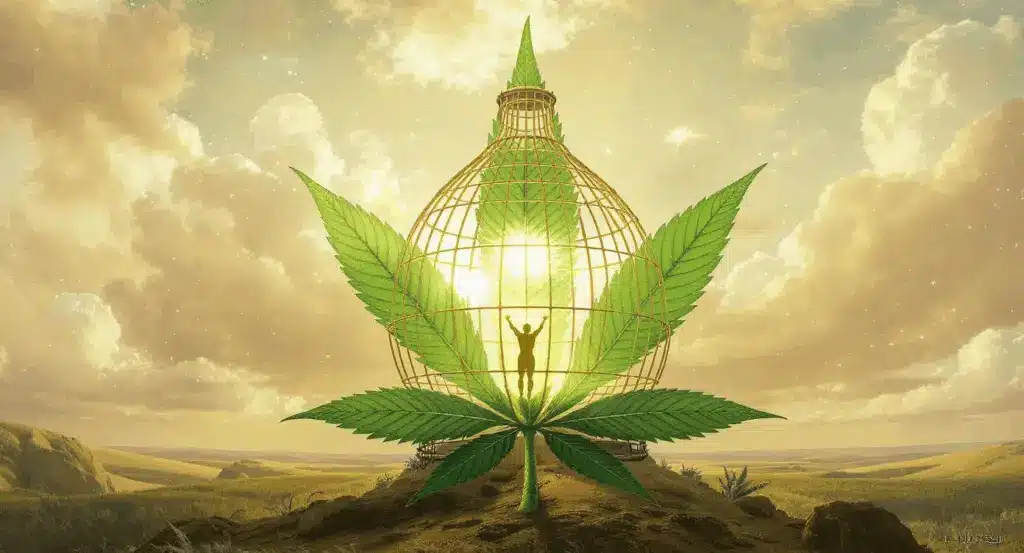Mitä marihuana on?
MARIHUANA ON SANA, JOTA KÄYTETÄÄN KUVAAMAAN... intialaisen hamppukasvin kuivatut kukat, siemenet ja lehdet.
Hasis on huumeiden sukulaismuoto, joka on valmistettu intialaisen hamppukasvin hartsista. Se on ruskehtavaa, ruskeaa tai mustaa, ja kuivattuna se puristetaan tangoiksi, tikuiksi tai palloksi. Se on keskimäärin kuusi kertaa vahvempaa kuin marihuana.
Kannabis tarkoittaa mitä tahansa intialaisesta hampusta saatavia huumeita, kuten marihuanaa ja hasista.
Nimestä riippumatta tämä huume on hallusinogeeni - aine, joka vääristää sitä, miten mieli hahmottaa maailmaa, jossa elämme.
Kannabiksen sisältämä kemikaali, joka aiheuttaa tämän vääristymän, tunnetaan nimellä THC. THC:n määrä tietyssä marihuanaerässä voi vaihdella huomattavasti, mutta kaiken kaikkiaan THC:n osuus on kasvanut viime vuosina.
Miten sitä käytetään
MARIHUANAA POLTETAAN YLEENSÄ savukkeena (ns. jointti), mutta sitä voidaan polttaa myös piipussa. Sitä sekoitetaan myös ruokaan ja syödään tai keitetään teeksi. Joskus käyttäjät avaavat sikarit ja poistavat tupakan ja korvaavat sen ruoholla. Jointeihin ja bluntteihin lisätään joskus muita voimakkaampia huumeita, kuten crack-kokaiinia tai PCP:tä (voimakas hallusinogeeni).
Kun henkilö polttaa jointin, hän yleensä tuntee sen vaikutuksen muutamassa minuutissa. Välittömät tuntemukset - kohonnut syke, heikentynyt koordinaatio ja tasapaino sekä unenomainen, epätodellinen mielentila - huipentuvat ensimmäisten kolmenkymmenen minuutin aikana. Lyhytaikaiset vaikutukset häviävät yleensä kahdessa tai kolmessa tunnissa, mutta ne voivat kestää pidempään riippuen siitä, kuinka paljon käyttäjä ottaa, THC:n voimakkuudesta ja muiden huumausaineiden lisäämisestä sekaan.
JOINT
Käsin kääritty kannabissavuke
LASIPUTKI
Yksi monista erilaisista, joita kutsutaan myös bongiksi
BROWNIE CAKE
Monissa elintarvikkeissa
ÖLJYUUTE
Laitetaan ruokaan tai juomaan ja höyrystetään (hengitetään höyrynä).
Koska tyypillinen käyttäjä hengittää enemmän savua ja pitää sitä pidempään kuin savuketta, jointti aiheuttaa vakavia vaikutuksia henkilön keuhkoihin. Kurkkukivun ja flunssan aiheuttaman epämukavuuden lisäksi on todettu, että yhden jointin nauttiminen altistaa syöpää aiheuttaville kemikaaleille yhtä paljon kuin jopa viiden savukkeen polttaminen.
Marihuanan käytön psyykkiset seuraukset ovat yhtä vakavia. Marihuanan polttajilla on huonompi muisti ja heikompi psyykkinen toimintakyky kuin ei-käyttäjillä.
Tutkijoiden marihuanaa antamat eläimet ovat jopa kärsineet aivojen rakenteellisista vaurioista.
Marihuanan tai ruohon käytön tunnistaminen
MARIHUANAA ELI RUOHOA VOI KÄYTTÄÄ... silputtuna, kuivana lehtituotteena tai öljynä ja hartsina. Näitä kahta viimeksi mainittua myydään nimillä hasis tai hasis. Hashia voi olla litteinä kakkuina. Hasisöljy on meripihkan tai ruskean väristä, ja sitä saatetaan myydä pienissä lasipulloissa.
Kun etsit merkkejä ruohon käytöstä, etsit pieniä pusseja, joissa on ruskeanvihreitä lehtiä, jotka näyttävät yrteiltä, pieniä jauhemaisen ruskean aineen palasia tai hyvin pieniä pulloja, joissa on meripihkanväristä tai ruskeaa nestettä.
Muita merkkejä ruohon käytöstä ovat henkilön huoneeseen tai ajoneuvoon jätetyt tarvikkeet. Pienet piiput, suuremmat monimutkaiset vesipiiput, joita kutsutaan bongiksi tai vesipiipuksi, ja savukkeiksi käärityt savukepaperit tai savustettujen käsin käärittyjen savukkeiden pienet päät ovat merkkejä ruohon käytöstä. Osavaltioissa, jotka ovat laillistaneet lääketieteellisen tai virkistysmarihuanan (tai läheisissä osavaltioissa), voi olla syötäviä keksien, brownieiden, juomien, karkkipatukoiden ja kovien karkkien muodossa.
Fyysiset merkit
- Bloodshot silmät
- Nopea syke
- Koordinoinnin puute
- Unelias, veltto
Käyttäytymisen merkit
- Hämmennys ja keskittymisen puute
- Lisääntynyt välipalojen himo
- Opintojen tai tavanomaisten aktiviteettien keskeyttäminen
- Epätavallisen puhelias
- Salailu
- Ajan väärinarviointi
Tarvikkeet
- Silputtu lehtimäinen jäte
- Pienet metalliklipsit
- Putket
- Erittäin pienet öljypullot
- Savukkeiksi käärittävät paperit
- Silmätipat
Marihuanan käytön vaikutukset
MARIHUANAN LYHYTAIKAISIA VAIKUTUKSIA OVAT vääristynyt käsitys ajasta ja tilasta, mikä lisää liikenneonnettomuuksien ja henkilövahinkojen riskiä. Ajattelun ja ongelmanratkaisun vaikeus voi haitata oppimista. Ja koska niin monet marihuanan väärinkäyttäjät ovat lukio- ja opiskeluikäisiä, tämä vaikutus on erityisen merkittävä.
Marihuanan runsas käyttö on yhteydessä mielenterveyden häiriöihin, kuten psykoosiin ja skitsofreniaan. Krooniseen käyttöön liittyy ahdistuksen ja masennuksen lisääntyminen. Ja koska marihuanan tehot ovat kasvaneet viimeisten kahden vuosikymmenen aikana, huumeiden väärinkäytöllä on suurempi mahdollisuus haitallisiin psyykkisiin vaikutuksiin.
Tosiasia on yksinkertaisesti se, että marihuana on nykyään paljon vahvempaa kuin mitä käytettiin kaksikymmentä vuotta sitten.
4%
Keskimääräinen THC-pitoisuus vuonna 1983
10%
Keskimääräinen THC-pitoisuus vuoteen 2008 mennessä
25%
THC-pitoisuus hydroponisessa marihuanassa
Hydroponisesti kasvatetun marihuanan (kasvatettu nesteessä, johon on lisätty ravinteita) näytteiden THC-pitoisuus voi olla 25 prosenttia tai enemmän. Hydroponista marihuanaa salakuljetetaan Kanadasta, ja sitä kasvatetaan sisätiloissa eri puolilla Yhdysvaltoja.
Marihuanan piilevät vaarat
KAIKEN LÄÄKEMARIHUANAA TUKEVAN JULKISUUDEN MYÖTÄ - ja tämän huumeen dekriminalisoinnin vaatimuksesta voi olla vaikea muistaa, että marihuana on todellakin vahingollista ja aiheuttaa riippuvuutta ja haitallisia vaikutuksia. Vaikka ne eivät ole otsikoissa, marihuanan väärinkäyttöön liittyy vakavia ja haitallisia vaikutuksia.
Marihuanan laillistamisen, dekriminalisoinnin tai lääkkeellistämisen kannattajat eivät kuitenkaan tee tätä selväksi nuorille, jotta he voisivat tehdä tietoon perustuvia valintoja.
Kun marihuana luokitellaan lääkehoitojen joukkoon, on selvää, että huume on vaaraton.
45%
Kuntoutukseen ruohoriippuvuuden vuoksi menevistä alle 21-vuotiaita.
55%
Kun ikä nostetaan 24 vuoteen ja nuorempiin
On siis tärkeää, että kaikki tuntevat riskit ja saavat tietoa sen sijaan, että hyväksyvät markkinointikampanjat kyseenalaistamatta.
Katujen nimet
Marihuanalle on yli 200 slangisanaa, mukaan lukien:
Weed
Potti
Herb
Ruoho
Valkoinen leski
Bhang
Mary Jane
Reefer
Särki
Texas Tea
Dope
Dagga
Hamppu
Kotimaiset
J
Astro Turf
Ganja
Hasis
Alkoholi vs. marihuana
ONKO JOINTIN POLTTAMINEN SAMA ASIA KUIN ALKOHOLIN JUOMINEN? Tässä ovat faktat:
| Aspect |
Alkoholi |
Marihuana |
| Kemiallinen koostumus |
Koostuu vain yhdestä aineesta: etanolista. |
Sisältää yli neljäsataa tunnettua kemikaalia, mukaan lukien samoja syöpää aiheuttavia aineita, joita esiintyy tupakansavussa. |
| Hengitysmenetelmä |
Ei hengitetä |
Toisin kuin savukkeiden tupakoitsijat, ruohonpolttajat hengittävät syvään ja pitävät savua mahdollisimman pitkään hengityksessä lisätäkseen huumeiden vaikutusta, mikä pahentaa keuhkovaurioita. |
| Immuunijärjestelmä |
Alkoholi ei vahingoita immuunijärjestelmää |
THC vahingoittaa immuunijärjestelmää |
| Kesto kehossa |
Alkoholi poistuu elimistöstä muutamassa tunnissa. |
THC säilyy elimistössä viikkoja, mahdollisesti kuukausia, käytön pituudesta ja intensiteetistä riippuen. |
Mikään edellä mainituista ei kuitenkaan vähättele alkoholin väärinkäytön vaaroja, jotka voivat olla yhtä haitallisia. Käyttäjien on kuitenkin oltava tietoisia siitä, että marihuanan sisältämät kemikaalit, joista osa on syöpää aiheuttavia, jäävät elimistöön vielä pitkään huumeiden käytön jälkeen.
Marihuanan haitalliset vaikutukset
MARIHUANAN KÄYTÖN VÄLITTÖMIIN VAIKUTUKSIIN KUULUVAT SEURAAVAT ASIAT nopea syke, sekavuus ja fyysisen koordinaation puute, jota seuraa usein masennus tai uneliaisuus. Jotkut käyttäjät kärsivät paniikkikohtauksista tai ahdistuksesta.
Marihuanan savu sisältää 50-70 prosenttia enemmän syöpää aiheuttavia aineita kuin tupakansavu. Eräässä laajassa tutkimuksessa todettiin, että yksi jointti voi aiheuttaa keuhkoille yhtä paljon vahinkoa kuin viisi tavallista savuketta, jotka poltetaan peräkkäin. Pitkään jointin polttaneet kärsivät usein keuhkoputkentulehduksesta, joka on hengitysteiden tulehdus.
Lääke voi vaikuttaa muuhunkin kuin fyysiseen terveyteesi. Australiassa tehdyt tutkimukset yhdistivät vuosia kestäneen runsaan marihuanan käytön aivojen poikkeavuuksiin. Tätä tukevat aiemmat tutkimukset marihuanan pitkäaikaisvaikutuksista, jotka osoittavat, että aivoissa tapahtuu samanlaisia muutoksia kuin muiden merkittävien huumeiden pitkäaikaisessa väärinkäytössä.
Useat tutkimukset ovat osoittaneet yhteyden marihuanan jatkuvan käytön ja psykoosin välillä.
Lyhyen aikavälin vaikutukset
- Aistien vääristyminen
- Paniikki
- Ahdistus
- Liikkeiden huono koordinointi
- Alentaa reaktioaikaa
- Käyttäjä tuntee itsensä uneliaaksi tai masentuneeksi alun jälkeen.
- Lisääntynyt sydämen syke (ja sydänkohtauksen riski).
- Riippuvuus
- Muistin heikkeneminen
- Arviointiin vaikuttaminen
- Heikentynyt oppimiskyky
- Vähentynyt koordinointi
- Alentunut verenpaine
- Uneliaisuus
- Tarkkaavaisuusongelmat
- Muuttunut aika- ja tilantaju
- Suurina annoksina hallusinaatioita, harhaluuloja, muistihäiriöitä ja sekavuutta.
Pitkän aikavälin vaikutukset
- Heikentynyt vastustuskyky tavanomaisia sairauksia (vilustuminen, keuhkoputkentulehdus jne.) vastaan.
- Immuunijärjestelmän tukahduttaminen
- Kasvuhäiriöt
- Epänormaalisti rakentuneiden solujen lisääntyminen elimistössä.
- Miespuolisten sukupuolihormonien vähentäminen
- Keuhkokuitujen nopea tuhoutuminen ja aivojen vauriot (vammat), jotka voivat olla pysyviä.
- Vähentynyt seksuaalinen kapasiteetti
- Opiskeluvaikeudet: heikentynyt kyky oppia ja säilyttää tietoa.
- Apatia, uneliaisuus, motivaation puute
- Persoonallisuuden ja mielialan muutokset
- Kyvyttömyys ymmärtää asioita selkeästi
- Pitkäaikainen psykoosi
Lisääntymisvaikutukset
Marihuana muuttaa siittiösolujen rakennetta, mikä muuttaa niitä. Näin ollen pienetkin määrät marihuanaa voivat aiheuttaa miehille tilapäistä hedelmättömyyttä. Marihuanan käyttö voi häiritä naisen kuukautiskiertoa.
Tutkimukset osoittavat, että paljon marihuanaa polttaneiden ihmisten henkiset toiminnot ovat yleensä heikentyneet. Marihuanan sisältämä THC häiritsee aivojen hermosoluja, mikä vaikuttaa muistiin.
Ruoho on yksi niistä harvoista huumeista, jotka aiheuttavat solujen epänormaalia jakautumista, joka johtaa vakaviin perinnöllisiin vikoihin. Raskaana oleva nainen, joka polttaa säännöllisesti marihuanaa tai hasista, voi synnyttää ennenaikaisesti alamittaisen ja alipainoisen vauvan. Viimeisten kymmenen vuoden aikana monet marihuanan käyttäjien lapset ovat syntyneet heikentyneellä aloitekyvyllä ja heikentyneellä keskittymiskyvyllä ja elämäntavoitteisiin pyrkimisellä. Tutkimukset viittaavat myös siihen, että huumausaineen synnytystä edeltävä (ennen syntymää tapahtuva) käyttö voi johtaa syntymävirheisiin, henkisiin poikkeavuuksiin ja lisääntyneeseen leukemiariskiin lapsilla.
Todellisia tarinoita, todellisia seurauksia
Suosittelu: Paul
"Aloitin käytön parhaan ystäväni kehotuksesta, joka sanoi, että olin liian pelkuri polttaakseni jointin ja juodakseni litran olutta. Olin tuolloin neljätoista. Seitsemän vuoden käyttämisen ja juomisen jälkeen löysin itseni tien päähän riippuvuudesta. En käyttänyt enää tunteakseni euforiaa. Käytin vain tunteakseni jonkinlaista normaaliutta.
Sitten minulla alkoi olla negatiivisia tunteita itsestäni ja omista kyvyistäni. Vihasin vainoharhaisuutta. Vihasin sitä, että katsoin koko ajan olkani yli. Vihasin todella sitä, etten luottanut ystäviini. Minusta tuli niin vainoharhainen, että karkotin onnistuneesti kaikki pois ja löysin itseni kauheasta paikasta, jossa kukaan ei halua olla - olin yksin. Heräsin aamulla ja aloin käyttää ja jatkoin käyttöä koko päivän."
-Paul
Matkalla huumeiden väärinkäyttöön
Koska suvaitsevaisuutta syntyy, marihuana voi johtaa siihen, että käyttäjät käyttävät vahvempia huumeita saadakseen saman huuman. Kun vaikutukset alkavat hiipua, henkilö saattaa turvautua voimakkaampiin huumeisiin päästäkseen eroon niistä ei-toivotuista olosuhteista, jotka saivat hänet alun perin käyttämään marihuanaa.
99.9%
Kokaiinin käyttäjistä aloitti käyttämällä ensin "porttihuumetta", kuten marihuanaa tai alkoholia.
85x
Marihuanaa käyttävät nuoret (12-17-vuotiaat) käyttävät kokaiinia 85 kertaa todennäköisemmin.
62%
Ennen 15 vuotta pilveä polttavista lapsista siirtyy kokaiiniin.
Suosittelut: Christian ja Veronique
"Sain ensimmäisen jointin kouluni leikkikentällä. Nyt olen heroiiniriippuvainen, ja olen juuri lopettanut kahdeksannen hoitojaksoni huumeriippuvuuden vuoksi."
-Christian
"Koulun opettaja, jossa kävin, poltti kolme tai neljä sätkää päivässä. Hän sai monet oppilaat aloittamaan jointtien polttamisen, minut mukaan lukien. Hänen diilerinsä patisti minua sitten aloittamaan heroiinin käytön, minkä tein vastustelematta. Siihen mennessä oli kuin omatuntoni olisi jo kuollut."
-Veronique
Marihuanan vieroitusoireet
JOTKUT VÄITTÄVÄT, ETTÄ MARIHUANA EI AIHEUTA RIIPPUVUUTTA. koska sillä ei ole dramaattisia vieroitusoireita kuten alkoholilla tai heroiinilla. Mutta tämä ei yksinkertaisesti ole totta. Koska marihuana on nykyään paljon vahvempaa kuin kaksikymmentä vuotta sitten, sen käytön lopettaminen voi aiheuttaa vakavia vieroitusoireita.
Muista, että vieroittautujan oireet voivat olla voimakkaampia tai heikompia riippuen siitä, kuinka paljon hän poltti ruohoa, kuinka kauan hän poltti ja hänen omasta ainutlaatuisesta fyysisestä ja psyykkisestä tilastaan. Jotkut ihmiset ovat esimerkiksi paljon herkempiä huumeille ja pääsevät näin ollen korkeammalle vähemmälläkin.
Vieroitusoireet
- Ärtyneisyys
- Unettomuus
- Ahdistus
- Painajaiset
- Viha ja vaihtelevat tunteet
- Päänsärky
- Masennus
- Ruokahaluttomuus
- himo jatkaa lääkkeen käyttöä
Ruohon polttamisen jatkaminen elämän ongelmista huolimatta
EHKÄ PAREMPI RIIPPUVUUDEN MITTARI on se, kokeeko henkilö huumausaineen käytöstä haittaa vai ei, mutta hänen on pakko käyttää huumausainetta ja hänen mielihalunsa on niin voimakas, että hän jatkaa silti.
National Institute on Drug Abuse -instituutin mukaan marihuanan raskaaseen väärinkäyttöön liittyy seuraavia ongelmia tai vaikutuksia:
Raskaaseen marihuanan käyttöön liittyvät elämänongelmat
- Mielenterveyden ja fyysisen terveyden heikkeneminen
- Suhdeongelmat
- Suurempi todennäköisyys keskeyttää koulunkäynti tai luopua tavoitteista.
- Heikommat arvosanat ja heikompi akateeminen menestys
- lisääntyneet poissaolot koulusta tai työstä
- Lisää työntekijöiden korvausvaatimuksia
- Vähemmän uramenestystä vertaisiinsa verrattuna
Riippuvainen marihuanan käyttäjä jatkaa huumeiden käyttöä tällaisista vaikutuksista huolimatta. On tavallista, että runsas marihuanan polttaja lakkaa välittämästä vahingoista ja keskittyy vain pysymään pilvessä. Tätä kutsutaan riippuvuudeksi. Se pätee yhtä lailla marihuanaan kuin crackiin, amfetamiiniin tai kipulääkkeisiin.
Mitä huumeet ovat?
LÄÄKKEET OVAT POHJIMMILTAAN MYRKKYJÄ. Vaikutus riippuu otetusta määrästä.
Pieni määrä toimii stimulanttina (nopeuttaa toimintaa). Suurempi määrä toimii rauhoittavana aineena (hidastaa sinua). Vielä suurempi määrä myrkyttää ja voi tappaa.
Tämä pätee kaikkiin lääkkeisiin. Vain vaikutuksen aikaansaamiseksi tarvittava määrä on erilainen.
Monilla lääkkeillä on kuitenkin toinenkin ongelma: ne vaikuttavat suoraan mieleen. Ne voivat vääristää käyttäjän käsitystä siitä, mitä hänen ympärillään tapahtuu. Tämän seurauksena henkilön toiminta voi olla outoa, järjetöntä, sopimatonta ja jopa tuhoisaa.
Huumeet estävät myös kaikki aistimukset, niin toivotut kuin ei-toivotutkin. Vaikka ne siis lievittävät kipua lyhytaikaisesti, ne myös hävittävät kyvyn ja valppauden ja hämärtävät ihmisen ajattelua.
Lääkkeet ovat lääkkeitä, joiden tarkoituksena on saada kehosi toimimaan paremmin nopeuttamalla, hidastamalla tai muuttamalla jotakin kehon toimintatapaa. Joskus ne ovat välttämättömiä. Lääkkeet ovat kuitenkin edelleen huumeita: ne toimivat piristävinä tai rauhoittavina aineina, ja liikaa niitä voi tappaa sinut. Jos lääkkeitä käytetään väärin, ne voivat olla yhtä vaarallisia kuin laittomat huumeet.
Tietoa Narcononista
NARCONON (TARKOITTAA "EI HUUMAUSAINEITA"). huume- ja alkoholikuntoutusohjelma on avoin kaikille, jotka haluavat lopettaa riippuvuutensa ja elää tuottavaa, päihteetöntä elämää. Narconon-ohjelmassa ei ainoastaan käsitellä huumeiden väärinkäytön heikentäviä vaikutuksia mieleen ja kehoon, vaan siinä myös autetaan selvittämään, miksi henkilö ylipäätään kääntyi huumeiden puoleen. Tämän tuloksena kymmenet tuhannet ihmiset ovat päässeet Narconon-ohjelmasta uuteen, huumeista vapaaseen elämään.
Huumekuntoutuksen lisäksi Narcononin huumeidenkäytön ehkäisytyöntekijät ovat valistaneet miljoonia koululaisia. Narcononilla on yli viidenkymmenen vuoden kokemus huumekasvatuksesta, ja se on todistetusti ollut tehokas keino pitää nuoret erossa huumeista.
Sanasto
keuhkoputkentulehdus:
keuhkoputkien (pienet putket, jotka kuljettavat ilmaa henkitorvesta keuhkoihin) tulehdus.
huutaminen:
jostakin asiasta sinnikäs vaatiminen, joka tehdään tavalla, jota on vaikea sivuuttaa.
crack-kokaiinia:
kokaiinin kristallimuoto, joka tavallisesti on jauheena. Sitä kutsutaan crackiksi, koska siitä kuuluu halkeileva tai poksahtava ääni, kun sitä kuumennetaan ja poltetaan.
heikentävä:
jonkun tekeminen fyysisesti tai henkisesti heikoksi.
dekriminalisointi:
rikosoikeudellisten seuraamusten poistaminen tai toiminnan tai toiminnan poistaminen rikosoikeudellisesta luokasta.
harhaluulo:
väärä tai virheellinen uskomus tai käsitys jostakin asiasta.
vääristymä:
Muutos jossakin havaitussa asiassa (kuten kuvassa, äänessä, hajussa jne.), jossa alkuperäiset mittasuhteet tai muut ominaisuudet muuttuvat jollakin tavalla.
etanolia:
väritön alkoholi, joka on valmistettu viljasta ja sokerista ja jota esiintyy alkoholijuomissa.
euforia:
suuren onnellisuuden ja hyvinvoinnin tunne.
hallusinaatiot:
havaintoja esineistä, joita ei todellisuudessa ole olemassa, ja aistimuksia, joilla ei ole mitään ulkoista syytä.
Intialainen hamppukasvi:
kasvi, josta valmistetaan marihuanaa ja hasista. Se on kotoisin Aasiasta, mutta sitä viljellään monissa osissa maailmaa.
irrationaalinen:
ei ajattele tai toimi järkevällä, järkevällä tavalla.
nauhoitettu:
sekoitettuna tai sekoitettuna johonkin.
leukemia:
veren syöpäsairaus.
vastuu:
jotakin, joka aiheuttaa ongelmia tai vähentää jonkun menestymisen todennäköisyyttä.
metamfetamiinia:
(myös metamfetamiini tai kristallimetamfetamiini) erittäin voimakas stimuloiva huume, joka aiheuttaa ruokahaluttomuutta, nopeaa sykettä, epäsäännöllistä sykettä, verenpaineen nousua, ärtyneisyyttä, ahdistuneisuutta, sekavuutta, kouristuksia ja jopa kuoleman. Se aiheuttaa voimakasta riippuvuutta. Metamfetamiinia valmistetaan usein pienissä, laittomissa laboratorioissa käyttäen erittäin myrkyllisiä kemikaaleja, joskus myös nestemäistä ammoniakkilannoitetta tai retkikeittimien polttoainetta. Huume on yleensä kiteistä valkoista jauhetta, joka liukenee veteen tai alkoholiin ja jota voidaan nuuskailla, polttaa tai ruiskuttaa.
mutaa:
tehdä jostakin asiasta sekavaa tai epäselvää, kuvaannollisesti niin kuin jos sekoittaisi mutaa veteen ja tekisi siitä epäselvempää.
hermosolu:
solu, joka välittää hermoimpulsseja ja on hermoston toiminnallinen perusyksikkö.
vainoharhaisuus:
mielentila, jossa joku uskoo järjettömästi, että muut ihmiset eivät pidä hänestä ja yrittävät vahingoittaa häntä.
vainoharhainen:
epärationaalisesti ja pakkomielteisesti uskovat, että muihin ihmisiin ei voi luottaa ja että he haluavat aiheuttaa vahinkoa.
tarvikkeet:
huumausaineiden valmistukseen, käyttöön tai kätkemiseen käytettävät laitteet, tuotteet tai materiaalit.
PCP:
(kutsutaan myös enkelipölyksi) lyhenne sanoista fenyylisykloheksyylipiperidiini, voimakas huume, joka aiheuttaa ympäristöstä irtautumisen tunteita, tunnekuohuja sekä muuttuneen tilan- ja ajantajun. Suuremmilla annoksilla esiintyy hallusinaatioita (näköhäiriöitä ja harhoja), ja joissakin tapauksissa sen käyttö johtaa aggressiiviseen käyttäytymiseen ja itsemurha-ajatuksiin. Slanginimi angel dust tulee huumeen jauhe- eli pölymuodosta. Jotkin muodot sisältävät haitallisia kemikaaleja, kuten suolahappoa (syövyttävä neste) ja syanidia (voimakas myrkky), jotka pahentavat käyttäjään kohdistuvia tuhoisia vaikutuksia.
psykologinen:
mielen, mentaalinen.
psykoosi:
vakava mielisairauden muoto, jossa henkilö ei kykene selviytymään itsestään tai ympäristöstään riittävän hyvin ja jota on hoidettava, jotta muita voidaan suojella häneltä tai jotta häntä voidaan suojella itseltään.
rationaalinen:
ajattelu järkevällä, järkevällä tavalla.
reaktioaika:
aika, jonka joku tarvitsee reagoidakseen tai tehdäkseen jotakin ympäristössä (tai testin aikana), kuten tehdäkseen päätöksen, ratkaistakseen ongelman jne.
skitsofrenia:
vakava mielenterveyden häiriö, jossa joku irrottautuu todellisuudesta; termiä käytetään myös epävirallisesti viittaamaan tilaan, jossa jollakulla on kaksi tai useampia näennäisiä persoonallisuuksia, joka tunnetaan myös nimellä jakautunut persoonallisuus (split personality), joka perustuu kreikkalaisiin juuriin skhizein (split) ja phren (mind).
rauhoittava:
lääke, jota käytetään aiheuttamaan uneliaisuutta ja lievittämään tilapäisesti kipua ja hermostuneisuutta tai levottomuutta.
näennäisyys:
pienin osa tai määrä jotakin.
aistillinen:
aisteja tai tuntoaistimuksia, kuten näköä, kuuloa, kosketusta, hajua, koskeva tai niihin liittyvä.
steriiliys:
tila, jossa ei pystytä tuottamaan lapsia.
stimulantti:
mikä tahansa aine, joka tilapäisesti lisää jonkin elintärkeän prosessin tai elimen toimintaa.
pyyhkiä pois:
poistaa tai poistaa jotain kokonaan.
vieroitusoireet:
epämiellyttävät fyysiset ja psyykkiset reaktiot, joita riippuvainen henkilö kokee lopettaessaan huumeiden käytön.




